Les skolithos de Mortain
Vous vous trouvez ici sur le site de la "petite chapelle", sur la commune de Mortain. La Petite Chapelle est construite sur un éperon de Grès armoricain. Un belvédère et une table d'orientation se trouve à l'arrière de la chapelle.
Tout de suite au pied de la chapelle, vous pouvez observer la présence d'un banc de grès armoricain. Ce banc de grès armoricain présente un faciès caractéristique dit "à Skolithos", c'est à dire qu'il se caractérise par la présence de terriers de vers fossilisés.
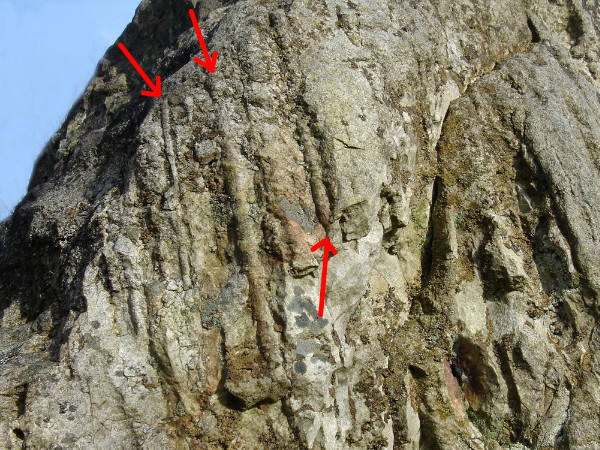
Skolithos sur un bloc rocheux à Mortain
Les fines canelures verticales que l'on peut ainsi observer sur les différents rochers correspondent à d'anciens terriers de vers, plus précisément des Tigillites, des sortes de vers de vase.
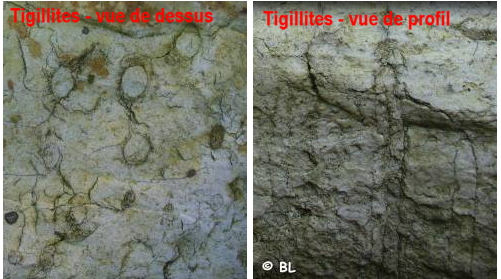
Tigillites, vue de dessus et vue de profil
Ces terriers sont des tubes simples, verticaux à légèrement inclinés qui ont des parois lisses avec des garnitures et un remplissage sans structure. Les tubes ont parfois la forme d'un J et ils ne se ramifient ou ne se croisent jamais. Ils peuvent atteindre des longueurs allant jusqu'à environ 35 cm et des diamètres allant jusqu'à environ 5 cm.
Si les parois des terriers ont des marques de grattage ou une texture de surface en forme de corde, alors le nom d'ichnogenus de Scoyenia est plus approprié. Les traces de Scoyenia sont faites par des insectes, et elles se ramifient parfois vers le bas (avec des branches inclinées vers l'horizontale), comme un Y inversé, tandis que les traces de Skolithos sont droites, presque verticales et ne se ramifient pas.

Comparaison d'ichnofaciès de type Scoyenia et Skolithos
Les terriers de Skolithos sont âgés du début du Cambrien à nos jours et se retrouvent partout dans le monde. Ils se trouvent dans les sédiments et les roches sédimentaires, principalement les sables et les grès. Ils sont typiquement d'origine marine et sont généralement associés à des environnements à haute énergie près du rivage. Ils ont également été signalés dans des milieux lacustres d'eau douce.

Position des principaux ichnofaciès
Comme vous pouvez l'observer tout autour de la petite chapelle, les bancs de grès armoricain sont assez épars, provenant du démantelement de la barre rocheuse. On parle là de phénomène de solifluxion, c'est à dire que la barre rocheuse, soumise à l'érosion, et par ses nombreuses fractures, a vu nombre de blocs rocheux être entraînés vers le bas.
Le principe de polarité stratigraphique
La détermination du « toit » et du « mur » d’une couche n’est pas toujours aisée. Il est parfois difficile de reconnaître le plan de stratification. C’est le cas, lorsque l’on rencontre une schistosité parallèle à un plan différent de celui du dépôt, due à des actions tectoniques. On recherche alors d’autres critères : pistes ou terriers d’animaux, racines, effets de lithophages, stratification entrecroisée (dans laquelle les lits sécants sont postérieurs aux lits coupés), etc.
La polarité stratigraphique est donc l'orientation originelle d'une couche géologique par rapport à la gravité. Le moyen classique de connaître cette orientation est la datation des couches d'une même série stratigraphique, les fossiles les plus anciens indiquant le bas et réciproquement. Il faut cependant veiller à ce que l'ordre des couches n'ait pas été modifié par des accidents tectoniques (failles, plis, etc ...) et qu'il n'y ait pas eu de remaniements de fossiles. Par ailleurs, cette orientation peut être déterminée par différents caractères de ces couches que l'on groupe sous le nom de critères de polarité :
1. organismes fixés restés en position de vie (polypiers, rudistes, végétaux, ...)
2. traces d'organismes (ichnofossilles) : empreintes de pas ou de reptation , le plus souvent conservés sous formes de moulages en relief à la base des bancs.
3. figures sédimentaires : rides construites par les mouvements de l'eau, ...
C'est donc ici que l'observation de la sédimentologie entre en compte : pour le grès armoricain, les Skolithos sont en effet des critères de polarité des bancs. Pour faire simple, les critères de polarité sont des indices permettant de savoir où étaient le haut et le bas. Dans cette optique, les fossiles sont des marqueurs stratigraphiques intéressants à étudier car ils apportent plusieurs informations. Ils présentent notamment des indications sur le milieu de vie (marin, forêt, ...), sur le temps géologique, mais aussi possiblement sur des phénomènes météorologiques majeures.
|
Pour loguer cette cache :
Pour valider votre visite sur le site, envoyez-moi vos réponses par mail ou centre de messagerie aux questions suivantes. Vous pouvez loguer "Found it" sans attendre mon accord, je vous contacterai si nécessaire.
A l'aide du descriptif et de vos observations sur place, répondez aux questions suivantes :
Q0. Optionnel, une photo de vous ou de votre GPS au niveau du site sera fortement appréciée.
Q1. à l'aide du descriptif et des schemas, indiquez pourquoi les skolithos sont des critères de polarité des bancs ?
Q2. parmi les trois types de caractères qui peuvent définir une polarité stratigraphique, à quelle catégorie appartient celle des skolithos ?
Q3. à quel "animal" les skolithos font-ils référence ?
Q4. au premier stage (stage 1) de la earth, face à la porte d'entrée à votre droite, vous pouvez observer un premier bloc rocheux (photo ci-dessous). Sur la partie en rouge, combien de skolithos pouvez-vous observez ? Pouvez-vous apercevoir des skolithos ailleurs sur ce rocher ?
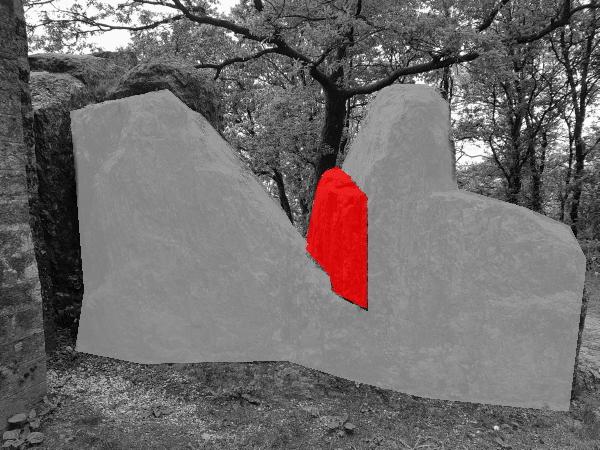
combien de skolithos pouvez-vous observer sur la partie rouge de ce bloc rocheux ?
Q5. au deuxième stage (stage 2) de la earth, sur la photo ci-dessous, la partie rouge masque un bloc rocheux. Repérez ce bloc rocheux, et placez vous en contrebas de celui-ci. A l'aide de l'image qui suit, les skolithos que vous observez sont-ils orientés de la façon bleue, rouge ou verte ?
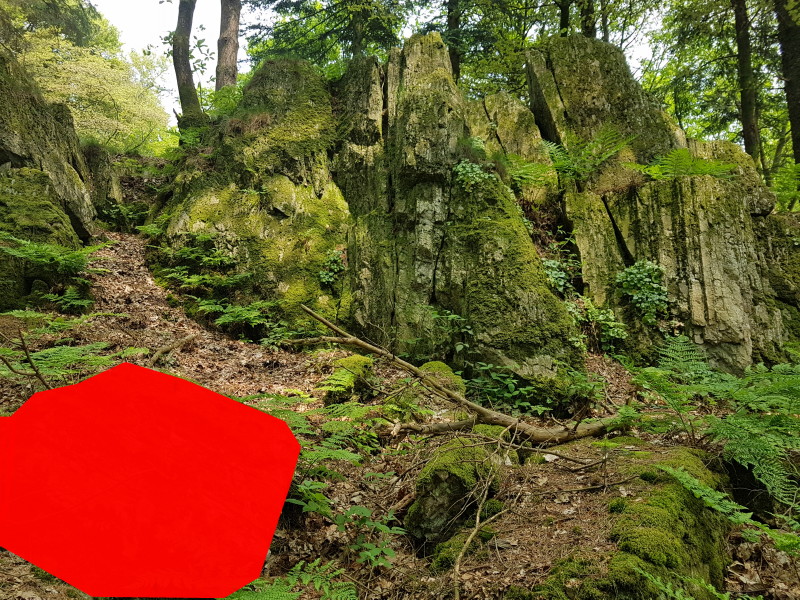
retrouvez le rocher :)
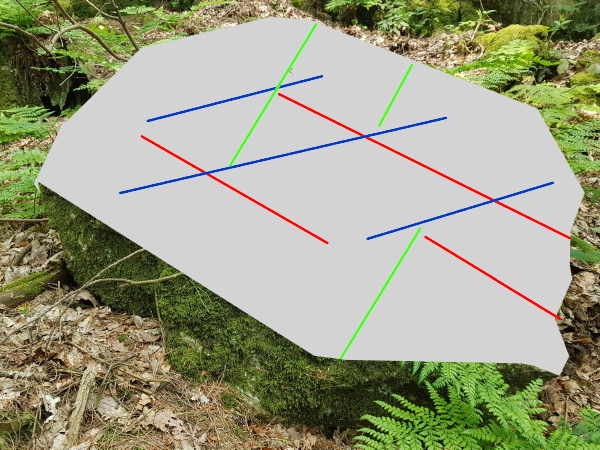
quelle est l'orientation des skolithos sur ce bloc rocheux : bleue, rouge ou verte ?
Q6. En vous aidant du descriptif et en observant ce bloc rocheux, pensez-vous disposer de suffisament d'éléments pour déterminer la partie haute du rocher ?
|
The skolithos of Mortain
You are here on the site of the "small chapel", in the municipality of Mortain. The Little Chapel is built on an Armorican sandstone spur. A belvedere and an orientation table is at the back of the chapel.
Immediately at the foot of the chapel, you can observe the presence of an Armorican sandstone bench. This Armorican sandstone bench has a characteristic facies called " in Skolithos ", ie it is characterized by the presence of fossilized worm burrows.

Skolithos on a boulder in Mortain
The fine vertical ribs that can thus be observed on the different rocks correspond to ancient worm terriers, more precisely Tigillites, some kinds of bloodworms.

Tigillites, top view and profile view
These burrows are simple, vertical to slightly sloping tubes that have smooth walls with fillings and a filling without structure. The tubes sometimes have the shape of a J and they do not ramify or cross each other. They can reach lengths up to about 35 cm and diameters up to about 5 cm.
If the burrow walls have scraping marks or a rope-like surface texture, then Scoyenia's ichnogenus name is more appropriate. The traces of Scoyenia are made by insects, and they sometimes branch down (with branches inclined horizontally), like an inverted Y, while the Skolithos traces are straight, almost vertical and do not branch out .

Comparison of Scoyenia and Skolithos type ichnofacies
Skolithos burrows are from the early Cambrian to the present day and are found all over the world. They are found in sediments and sedimentary rocks, mainly sands and sandstones. They are typically of marine origin and are generally associated with high energy environments near the shore. They have also been reported in lake freshwater environments.

Position of the main ichnofacies
As you can see it all around the little chapel, the Armorican sandstone benches are quite scattered, coming from the dismantling of the rock bar. This is called the solifluction phenomenon, that is to say that the rocky bar, subjected to erosion, and by its numerous fractures, saw many boulders being driven downwards.
The principle of stratigraphic younging
Determining the "roof" and "wall" of a layer is not always easy. It is sometimes difficult to recognize the stratification plan. This is the case when one encounters a schistosity parallel to a plane different from that of the deposit, due to tectonic actions. We then look for other criteria: animal tracks or burrows, roots, lithophagous effects, criss-crossing stratification (in which the secant beds are posterior to the cut beds), and so on.
The stratigraphic younging is therefore the original orientation of a geological layer with respect to gravity. The classic way of knowing this orientation is the dating of the layers of the same stratigraphic series, the oldest fossils indicating the bottom and vice versa. However, care must be taken that the order of the layers has not been modified by tectonic accidents (faults, folds, etc ...) and that there has been no reworking of fossils. Moreover, this orientation can be determined by different characters of these layers that are grouped under the name of polarity criteria:
1. fixed organisms remained in life position (polypiers, rudists, plants, ...)
2. traces of organisms (ichnofossils): footprints or crawling, most often preserved in the form of relief moldings at the base of the benches.
3. sedimentary figures: wrinkles built by the movements of water, ...
It is here that the observation of sedimentology is taken into account: for the Armorican sandstone, the Skolithos are indeed bench polarity criteria . To put it simply, the polarity criteria are clues as to where the top and bottom were. In this perspective, fossils are interesting stratigraphic markers to study because they provide more information. They include information on the environment (marine, forest, ...), on geological time, but also possibly on major weather phenomena.
|
To log this cache :
To validate your visit on the site, send me your answers by mail or message center to the following questions. You can log "Found it" without waiting for my agreement, I will contact you if necessary.
Using the description and information that you can observe on site, answer the following questions : :
Q0. Optional, a photo of you or your GPS on the site will be highly appreciated.
Q1. using the description and schematics, indicate why skolithos are bench polarity criteria ?
Q2. of the three types of characters that can define a stratigraphic polarity, which category belongs to the skolithos ?
Q3. to what "animal" do skolithos refer to ?
Q4. At the first stage (stage 1) of the earth, facing the door on your right, you can see a first block of rock (photo below). On the red part, how many skolithos can you observe? Can you see skolithos elsewhere on this rock?

how many skolithos can you observe on the red part of this boulder ?
Q5. at the second stage (stage 2) of the earth, in the photo below, the red part masks a boulder. Locate this block of rock, and place it below it. With the help of the following image, are the skolithos you observe oriented in blue, red or green?

Find the boulder :)

what is the orientation of skolithos on this block: blue, red or green ?
Q6. By using the description and observing this block of rock, do you think you have enough elements to determine the high part of the rock ?
|